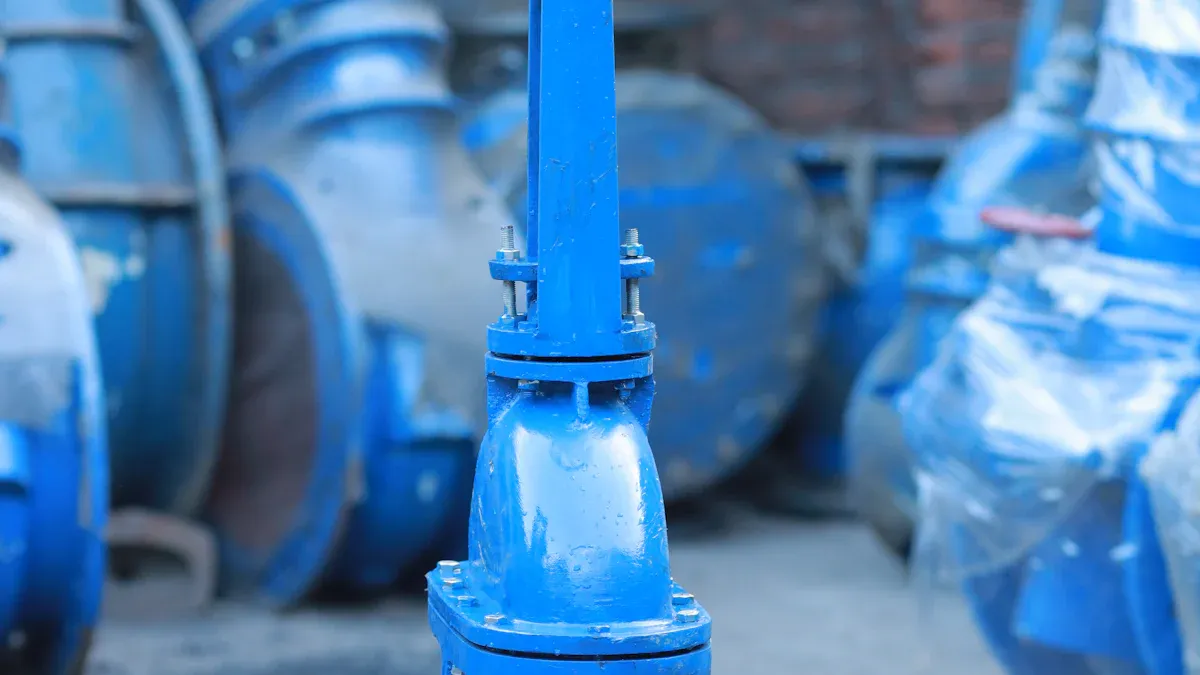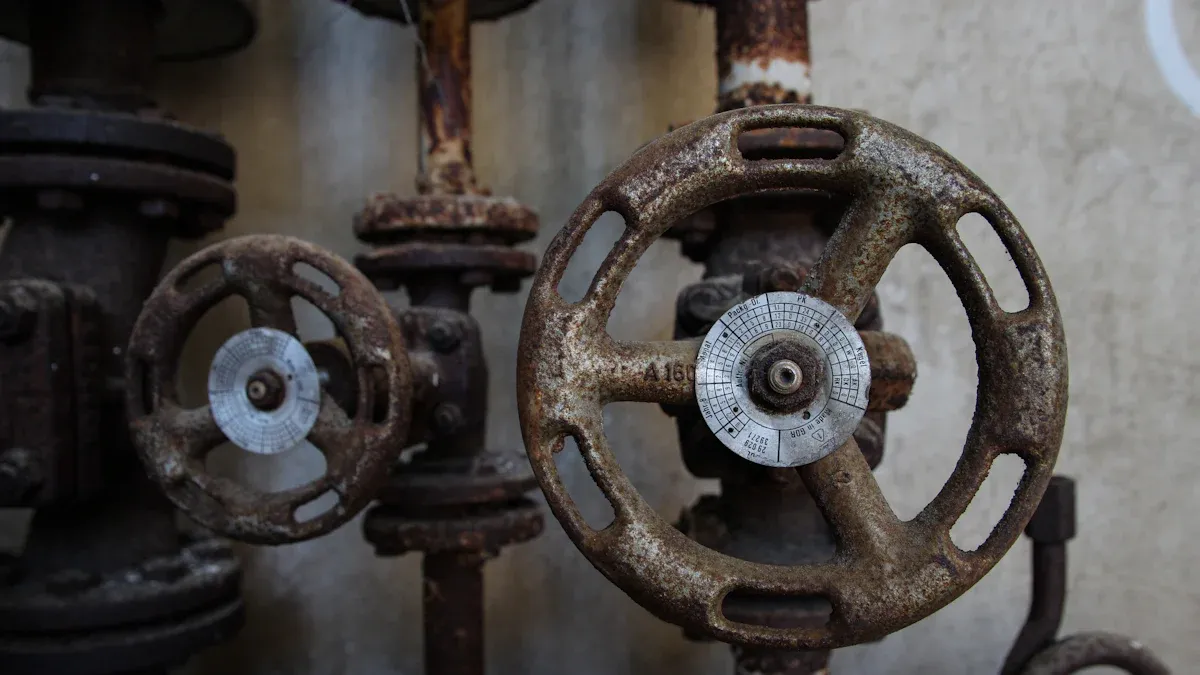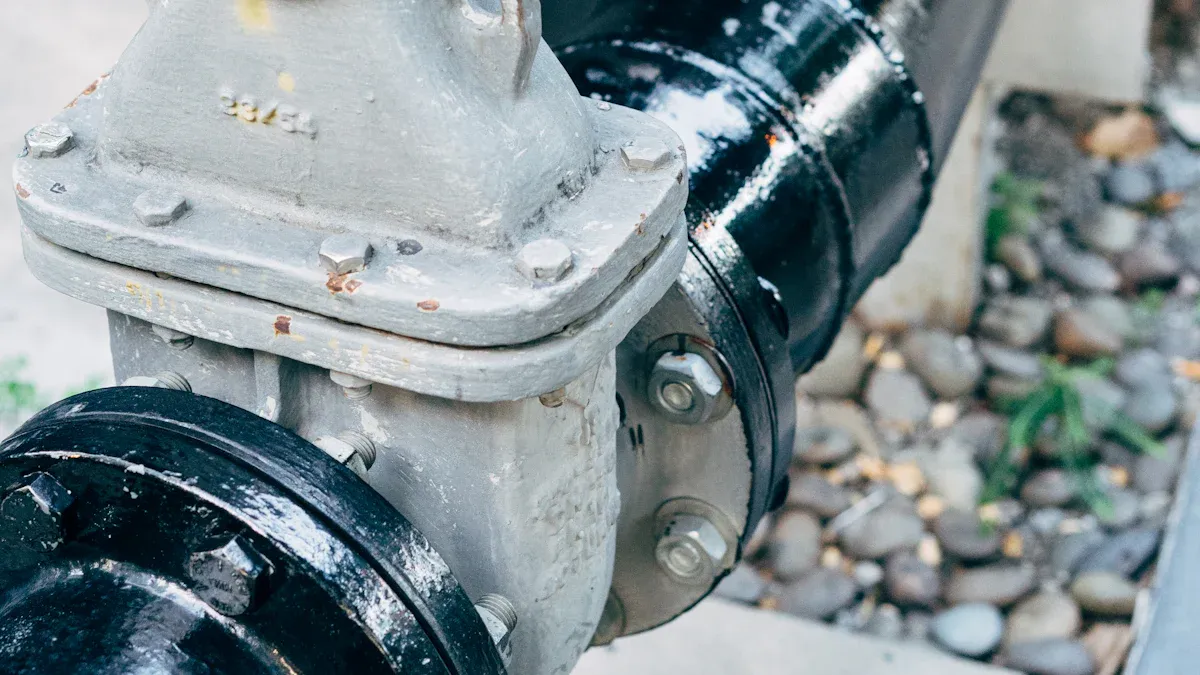Forging Valve vs Casting Valve Which Is Right for Your Project

Many engineers and project managers often ask which is better for their needs: forging valve vs casting valve. The answer depends on several factors. Forged valves have higher strength and resist cracks and porosity. They work well in high-pressure and high-temperature systems. Cast valves allow for complex shapes and are usually more cost-effective. They need careful inspection to avoid impurities. Each type suits different applications, so careful review of project needs helps guide the right choice.
Key Takeaways
- Forged valves offer higher strength and durability, making them ideal for high-pressure and high-temperature projects.
- Cast valves allow complex shapes and cost less upfront, fitting projects with intricate designs or tight budgets.
- Forging reduces defects like cracks and porosity, while casting may have more internal flaws needing careful inspection.
- Choosing the right valve depends on project needs such as strength, design complexity, cost, and operating conditions.
- Quality testing like ultrasonic and radiography ensures safety and reliability for both forged and cast valves.
Quick Comparison
forging valve vs casting valve
Choosing between forging valve vs casting valve often starts with a quick look at their main features. The table below gives a fast overview to help readers compare the two options:
| Feature | Forged Valve | Cast Valve |
|---|---|---|
| Manufacturing Process | Shaped by pressing or hammering solid metal | Formed by pouring molten metal into a mold |
| Strength | Very high, due to aligned grain structure | Moderate, with less consistent grain |
| Cost | Higher upfront, lower long-term maintenance | Lower initial cost, may need more repairs |
| Design Complexity | Best for simple to moderate shapes | Handles complex and intricate shapes |
| Defect Risk | Low risk of porosity and cracks | Higher risk of porosity and flaws |
| Typical Applications | High-pressure, high-temperature systems | General service, complex or large valves |
Pros and Cons
Industry case studies and technical reports highlight several important points when comparing forging valve vs casting valve. Each method offers unique advantages and drawbacks:
- Pros of Forged Valves:
- Superior strength from realigned grain structure
- High durability under pressure and heat
- Fewer weak points due to reduced porosity
- Precision in design for reliable performance
- Lower maintenance needs over time
- Cons of Forged Valves:
- Higher initial cost
- Less flexibility for complex shapes
- Pros of Cast Valves:
- Can create intricate and versatile designs
- More cost-effective for large production runs
- Smoother surface finish
- Cons of Cast Valves:
- Greater risk of microscopic flaws and porosity
- Lower tensile strength and durability in extreme conditions
Note: The best choice in the forging valve vs casting valve debate depends on project needs. Forged valves suit demanding environments, while cast valves work well for complex shapes and lower budgets.
Process Overview

Forging
Forging shapes metal by applying compressive forces with hammers or presses. This process refines the grain structure and aligns it along the shape of the valve. Modern forging uses powerful machines with real-time monitoring to control pressure and temperature. These controls help reduce common defects such as cracks, voids, and laps. Non-destructive testing methods like ultrasonic testing and radiography check for internal flaws. Forged valves show high consistency and strength because the process compresses the metal, making it dense and tough. Optical microscopy and electron backscatter diffraction studies reveal that forging reduces grain size and improves alignment, which boosts durability and resistance to cracking.
Tip: Forged valves often meet strict quality standards due to precise process management and advanced testing.
Casting
Casting forms valves by pouring molten metal into a mold. This method allows for complex shapes and detailed designs. Different casting techniques, such as permanent mold, greensand, and die casting, offer various benefits and drawbacks. Permanent mold casting provides good accuracy but can suffer from mold wear. Greensand casting is versatile but may have lower surface finish quality. Die casting creates smooth surfaces but can introduce porosity. Many casting defects result from poor control of production parameters. Traceability systems and real-time monitoring help reduce these defects. Studies show that casting can produce valves with moderate strength, but the risk of porosity and internal flaws remains higher than in forging.
Property Impact
The choice between forging and casting directly affects valve properties. The table below summarizes key differences:
| Property | Forging Process Impact | Casting Process Impact |
|---|---|---|
| Strength | Higher tensile strength and impact resistance due to refined grain structure | Moderate strength; prone to porosity defects (2-5%) |
| Defect Rate | Low porosity and voids due to compressive forces refining grain structure | Higher porosity and internal defects from cooling process |
| Durability | Excellent resistance to thermal fatigue, corrosion, and wear | More vulnerable to stress cracks under high cycling or extreme temperatures |
| Pressure Tolerance | Suitable for high-pressure systems (e.g., PN40, 2500Lb) | Suitable for lower-pressure applications (e.g., PN16–PN40) |
| Temperature Range | Can withstand up to 650°C (e.g., F92 alloys) | Limited performance above 600°C due to material degradation |
Experimental results show that forging aligns grain flow, which increases fatigue strength and impact toughness. Casting can achieve complex shapes but may have more defects and lower durability. In the forging valve vs casting valve debate, forging offers better mechanical properties, while casting provides design flexibility.
Key Factors
Strength & Durability
- Forged valves show higher strength and toughness. The forging process aligns the metal’s grain, which increases resistance to pressure and wear.
- Cast valves have moderate strength. They may develop small flaws or pores, which can lower durability in harsh conditions.
- Mechanical strength is measured by properties like tensile strength and fracture energy. Forged valves often outperform cast valves in these tests.
Engineers choose forged valves for high-pressure or high-temperature systems because they last longer and resist cracking.
Design Complexity
- Casting allows for complex shapes, internal cavities, and large parts. This method works well for intricate designs and custom features.
- Forging is best for simple or moderately shaped valves. Complex shapes often require extra machining after forging.
- The table below compares design complexity and related features:
| Aspect | Casting Method | Forging Method |
|---|---|---|
| Design Complexity | Handles complex, intricate shapes | Limited to simpler shapes |
| Strength | Lower tensile strength | Higher strength and durability |
| Post-Processing | Less machining needed | More machining for details |
Cost & Volume
- Forging usually costs more per piece and suits smaller production runs.
- Casting is more cost-effective for high-volume orders. The cost per valve drops as production increases.
- Casting benefits from automation and faster production speeds, especially for complex shapes.
- Process yield affects casting cost. Lower yields raise the cost per kilogram, while higher yields lower it, but may increase defects.
Material Options
- Both forging and casting use a wide range of materials, including carbon steel, low-alloy steel, stainless steel, and specialty alloys.
- Forged valves often use materials like A105 carbon steel or F316 stainless steel for high strength.
- Cast valves use materials such as WCB carbon steel or CF8M stainless steel, which suit larger sizes and varied applications.
- Forged valves are common in sizes 2 inches and below, while cast valves are typical for larger sizes.
Accuracy & Finish
- Forged valves achieve tight tolerances and smooth surfaces, especially at sealing points.
- Cast valves offer good dimensional accuracy but may need extra machining for a perfect fit.
- Forged valves usually have fewer surface flaws and lower leakage rates under pressure.
- Cast valves can have small pores, but modern controls and machining help reduce this issue.
Defect Risks
- Forged valves have a low risk of porosity and cracks because the process compresses and aligns the metal.
- Cast valves face a higher risk of internal flaws, such as pores or shrinkage defects, especially if process controls are weak.
- Quality checks like ultrasonic testing and radiography help detect and reduce defects in both types.
When comparing forging valve vs casting valve, project needs such as strength, design, cost, and quality control play a key role in the final decision.
When to Choose
Forged Valves
Engineers often select forged valves for projects that demand high strength, durability, and safety. These valves perform well in high-pressure and high-temperature environments. The forging process creates a dense, aligned grain structure, which increases resistance to wear, fatigue, and corrosion. This makes forged valves ideal for power plants, oil and gas pipelines, and chemical processing facilities.
A comparison of steel grades used in forging shows why these valves excel in tough conditions:
| Steel Grade | Key Properties | Performance in Tests | Durability Insights |
|---|---|---|---|
| 1.2365 (WLV) | High resistance to abrasive wear at elevated temperatures; resistance to plastic deformation | Showed slower wear and less calotte height loss compared to others | Optimal structural fit reduces frictional forces; even carbide distribution enhances strength and impact resistance |
| 1.2344 (WCLV) | Conventional hot work tool steel | Experienced intensive wear and faster calotte height loss | Less durable under high temperature and pressure conditions |
| Unimax | Electro-slag remelted steel with even carbide distribution and reduced inclusions | Showed intensive wear similar to 1.2344 | Improved mechanical properties but still less durable than 1.2365 in tests |
| W360 | Hot work tool steel | Exhibited slower wear similar to 1.2365 | Good durability attributed to material properties |
Steels like 1.2365 and those produced by electro-slag remelting offer even carbide distribution and fewer impurities. This microstructure boosts wear resistance and mechanical strength, which is critical for valves in demanding applications. The durability of forged valves depends on the right choice of steel, proper heat treatment, and careful design.
A case study from the energy sector highlights the benefits of forged valves. In combined cycle power plants, engineers used forged valve cages made with advanced alloys. These valves performed well in highly erosive environments, showing excellent wear resistance and reliability. The project demonstrated that forged valves can handle complex designs and strict safety requirements without sacrificing performance.
Cast Valves
Cast valves provide a practical solution for projects that require complex shapes, large sizes, or cost savings. The casting process allows manufacturers to create intricate designs and internal cavities that would be difficult or expensive to achieve with forging. Cast valves are common in water treatment plants, HVAC systems, and general industrial applications.
- Casting supports a wide range of materials, including stainless steel, carbon steel, and specialty alloys. This flexibility helps engineers match the valve material to the specific needs of the project.
- The process enables the production of large and complex valves at a lower cost, especially for high-volume orders.
- Tooling costs for casting are generally lower, making it an economical choice for projects with tight budgets.
- Cast valves may have internal porosity or lower mechanical strength, so they are less suitable for high-pressure or high-temperature environments.
Decision Guide
Choosing between forged and cast valves depends on the specific requirements of the project. The table below summarizes key performance metrics and typical conditions for each type:
| Performance Metric / Condition | Forged Valves | Cast Valves |
|---|---|---|
| Strength | High strength due to dense crystal structure | Lower strength; internal defects possible |
| Durability | High durability; resists fatigue and damage | Lower fatigue life; more prone to defects |
| Corrosion Resistance | Superior due to fine grain structure | Inferior; internal defects may exist |
| Fatigue Life | Longer | Shorter |
| Sealing Performance | Better sealing; precise surfaces | Less precise; higher leakage risk |
| Stability in Vibration | High stability | Less stable |
| High Pressure/Temperature | Preferred for high-pressure/high-temp use | Not ideal for high-pressure applications |
| Low Temperature | Maintains toughness | Increased brittleness |
| Cost | Higher initial cost | More cost-effective for complex shapes |
| Application Suitability | Critical, high-stress environments | Complex shapes, large sizes, cost-sensitive |
Tip: For projects where safety, pressure, and durability matter most, forged valves offer the best performance. For projects that need complex shapes or must stay within a budget, cast valves provide a flexible and economical solution.
When comparing forging valve vs casting valve, project managers should consider the operating environment, design needs, and budget. Forged valves suit critical systems with high demands, while cast valves work well for less extreme conditions and complex designs.
Applications

Forged Valve Uses
Forged valves play a key role in industries that demand high strength and reliability. Many engineers choose forged valves for oil and gas pipelines, power generation plants, and chemical processing facilities. These valves handle high pressure and temperature, making them suitable for critical systems. Advances in forging technology, such as precision and cold forging, have improved the performance and efficiency of forged valves. The global industrial valves market, valued at about $73.7 billion in 2023, shows strong demand for forged steel valves in sectors where safety and durability matter most. In Japan, forged valves see widespread use due to strict regulatory standards and the need for reliable operation in industrial settings.
Forged valves often appear in high-pressure flow control, steam lines, and safety systems where failure is not an option.
Cast Valve Uses
Cast valves offer flexibility for complex shapes and large sizes. Many industries use cast valves in water and wastewater treatment, HVAC systems, and general industrial applications. Cast steel valves are common in oil and gas, power generation, and chemical processing because they resist high pressure and temperature. The oil and gas sector, in particular, relies on cast steel check valves to prevent backflow and handle corrosive environments. Cast iron valves are popular in municipal waterworks for their wear resistance and cost-effectiveness. Market data shows that cast valves meet the needs of growing infrastructure and strict safety regulations.
- Cast valves support a wide range of materials and sizes.
- They enable cost-effective production for large or complex valve designs.
- Many industries prefer cast valves for their versatility and lower initial cost.
Industry Examples
| Industry Sector | Valve Type | Usage % | Key Operational Conditions | Common Materials |
|---|---|---|---|---|
| Oil & Gas | Ball Valve | ~30% | Pressures 200-15,000 psi; -46°C to 250°C | Steel, stainless steel |
| Oil & Gas | Gate Valve | ~25% | High pressure flow control | Forged steel, cast steel |
| Energy Generation | Gate Valve | ~30% | High pressure steam and water | Cast iron, stainless steel |
| Pharmaceuticals | Diaphragm Valve | 40% | Sterile processing, contamination control | Stainless steel, PTFE, EPDM |
| Marine & Shipping | Ball Valve | ~25-30% | Handling seawater, fuel flow | Bronze, stainless steel |
Real-world projects highlight the effectiveness of both forged and cast valves. For example, a single-piece nickel aluminum bronze casting in marine propulsion replaced complex assemblies, improving durability. In nuclear fusion machinery, large investment castings withstand extreme temperatures, showing the strength and stability of cast valves. These examples demonstrate how both forged and cast valves meet the unique needs of different industries, supporting safe and efficient operations.
Selecting between forging and casting valves depends on project needs. Each method offers unique strengths. For example, forging provides higher mechanical strength and better fatigue resistance, while casting supports complex shapes and lower production costs. The table below highlights key differences:
| Factor | Casting Valves | Forged Valves |
|---|---|---|
| Strength | Isotropic, standard-based | Anisotropic, higher fatigue |
| Design Flexibility | High, easy to modify | Low, costly to change |
| Cost | Lower for complex shapes | Lower for simple, high volume |
| Application | Large, complex, multiaxial | High strength, uniaxial load |
Project managers should review their requirements, compare these factors, and consult valve experts for the best results. For further guidance, reach out to a trusted supplier or manufacturer.
FAQ
What is the main difference between forged and cast valves?
Forged valves use solid metal shaped by force. Cast valves form by pouring molten metal into molds. Forged valves have higher strength. Cast valves allow for more complex shapes.
Are forged valves always better than cast valves?
No. Forged valves work best in high-pressure or high-temperature systems. Cast valves fit projects that need complex shapes or lower costs. The right choice depends on the project’s needs.
Can cast valves handle high pressure?
Cast valves can handle moderate pressure. Forged valves perform better in very high-pressure systems. Engineers choose forged valves for safety in extreme conditions.
Which type of valve costs less?
Cast valves usually cost less to make, especially for large or complex shapes. Forged valves cost more at first but may save money over time due to fewer repairs.
How can someone check valve quality?
Engineers use tests like ultrasonic testing and radiography. These tests find hidden flaws inside both forged and cast valves. Quality checks help ensure safe and reliable valves.
